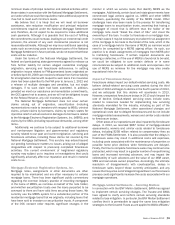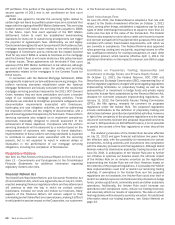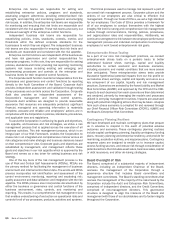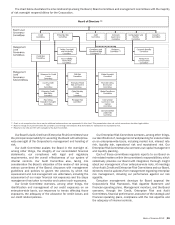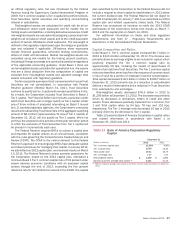Bank of America 2012 Annual Report Download - page 69
Download and view the complete annual report
Please find page 69 of the 2012 Bank of America annual report below. You can navigate through the pages in the report by either clicking on the pages listed below, or by using the keyword search tool below to find specific information within the annual report.
Bank of America 2012 67
an official regulatory ratio, but was introduced by the Federal
Reserve during the Supervisory Capital Assessment Program in
2009. Tier 1 common capital is Tier 1 capital less preferred stock,
Trust Securities, hybrid securities and qualifying noncontrolling
interest in subsidiaries.
Risk-weighted assets are calculated for credit risk for all on-
and off-balance sheet credit exposures and for market risk on
trading assets and liabilities, including derivative exposures. Credit
risk-weighted assets are calculated by assigning a prescribed risk-
weight to all on-balance sheet assets and to the credit equivalent
amount of certain off-balance sheet exposures. The risk-weight is
defined in the regulatory rules based upon the obligor or guarantor
type and collateral if applicable. Off-balance sheet exposures
include financial guarantees, unfunded lending commitments,
letters of credit and derivatives. Market risk-weighted assets are
calculated using risk models for the trading account positions,
including all foreign exchange and commodity positions regardless
of the applicable accounting guidance. Under Basel 1 there are
no risk-weighted assets calculated for operational risk. Any assets
that are a direct deduction from the computation of capital are
excluded from risk-weighted assets and adjusted average total
assets consistent with regulatory guidance.
Certain corporate-sponsored trust companies which issue Trust
Securities are not consolidated. In accordance with Federal
Reserve guidance effective March 31, 2011, Trust Securities
continue to qualify as Tier 1 capital with revised quantitative limits.
As a result, the Corporation includes Trust Securities in Basel 1
Tier 1 capital. The Financial Reform Act includes a provision under
which Trust Securities will no longer qualify as Tier 1 capital. Under
one of three notices of proposed rulemaking on Basel 3 issued
by U.S. banking regulatory agencies, the Corporation’s previously
issued and outstanding Trust Securities in the aggregate qualifying
amount of $6.2 billion (approximately 51 bps of Tier 1 capital) at
December 31, 2012, will not qualify as Tier 1 capital. While not
yet final, the proposed rules provide a three-year transition period
in which the exclusion of Trust Securities from Tier 1 capital will
be phased in incrementally each year.
The Federal Reserve requires BHCs to submit a capital plan
and requests for capital actions on an annual basis, consistent
with the rules governing the Comprehensive Capital Analysis and
Review (CCAR). The CCAR is the central element to the Federal
Reserve’s approach to ensuring large BHCs have adequate capital
and robust processes for managing their capital. In January 2012,
we submitted our 2012 capital plan, and received results on March
13, 2012. The Federal Reserve’s stress scenario projections for
the Corporation, based on the 2012 capital plan, estimated a
minimum Basel 1 Tier 1 common capital ratio of 5.9 percent under
severe adverse economic conditions with all proposed capital
actions through the end of 2013, exceeding the five percent
reference rate for all institutions involved in the CCAR. The capital
plan submitted by the Corporation to the Federal Reserve did not
include a request to return capital to stockholders in 2012 above
the current dividend rate. The Federal Reserve did not object to
our 2012 capital plan. On January 7, 2013, we submitted our 2013
capital plan and related supervisory stress tests. The Federal
Reserve has announced its intention to notify the 2013 CCAR
participants of the supervisory stress test results on March 7,
2013 and the capital plan on March 14, 2013.
For additional information on these and other regulatory
requirements, see Note 17 – Regulatory Requirements and
Restrictions to the Consolidated Financial Statements.
Capital Composition and Ratios
Under Basel 1, Tier 1 common capital increased $6.7 billion in
2012 to $133.4 billion at December 31, 2012. The increase was
primarily driven by earnings eligible to be included in capital, which
positively impacted the Tier 1 common capital ratio by
approximately 59 bps, including the impact of repurchases of
certain of our debt and Trust Securities. The Tier 1 common capital
ratio also benefited seven bps from the issuance of common stock
in lieu of cash for a portion of employee incentive compensation.
Total capital decreased $18.4 billion in 2012 to $196.7 billion at
December 31, 2012 primarily due to a reduction in subordinated
debt as a result of redemptions and a reduction in Trust Securities
from redemptions and exchanges.
Risk-weighted assets decreased $78.5 billion in 2012 to
$1,206 billion at December 31, 2012. The decrease was primarily
driven by decreases in derivatives, letters of credit and other
assets. These decreases positively impacted Tier 1 common, Tier
1 and Total capital ratios by 64 bps, 78 bps and 102 bps,
respectively. The Tier 1 leverage ratio decreased 16 bps in 2012
primarily driven by the decrease in Tier 1 capital.
Table 13 presents Bank of America Corporation’s capital ratios
and related information in accordance with Basel 1 at
December 31, 2012 and 2011.
Table 13 Bank of America Corporation Regulatory
Capital
December 31
(Dollars in billions) 2012 2011
Tier 1 common capital ratio 11.06% 9.86%
Tier 1 capital ratio 12.89 12.40
Total capital ratio 16.31 16.75
Tier 1 leverage ratio 7.37 7.53
Risk-weighted assets $ 1,206 $ 1,284
Adjusted quarterly average total assets (1) 2,111 2,114
(1) Reflects adjusted average total assets for the three months ended December 31, 2012 and
2011.




